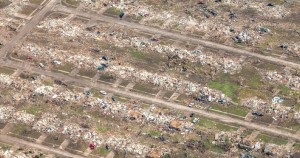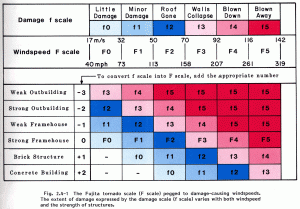Property Damage and Weather
By Michael FaginHistorical Weather Data, Tornado Damage, Weather ExpertWith 0 commentsProperty Damage and Weather hazards come in many forms. Hurricanes, tornadoes, hailstorms, floods, winter weather and wildfires are all common culprits that bear their own sets of potential threats.
Hurricanes
The least common of the six, hurricanes are good to begin with because they often encompass most of the ways that property damage and weather collide. Warm water and moist, warm air can begin as eddies, evolve into tropical depressions, then into tropical storms and, if all of the necessary criteria preexist, hurricanes. Rain-cooled cold air flows out of the tops of these atmospheric machines, which in turn draws warm, moist air from the surface into the vacuum that’s made in its wake. This cycle is continued until any one of the conditions is no longer met, which can last for weeks on end. The 1899 San Ciriaco Category 4 hurricane is the current record holder having lasted from August 3rd until September 12th.
Hurricanes can destroy property in a multitude of ways. For example, windows can break. Roofs and siding can be pulled apart. Door hinges commonly fail. Hi-speed debris can damage everything from garage doors to entire roofs. Hurricanes typically suck out roof turbines and often claim many boats. Gas leaks and fires are common. Strong winds and floods can sweep away property. When the power remains out for long periods or during a serious flood, each home may lose hundreds of dollars from food spoiling. Basements often flood. Basic moisture damage can be incredibly costly and dangerous (Cornell’s Mold Fact Sheet.) Flooding can also lead to septic tank issues and water contamination.
Hail
Hail originates when water in its coldest natural form accretes on ice particles, which, under the governance of the electromagnetic force, may grow to the size of snowballs, given sufficient atmospheric churning and ambient moisture. Other ice particles and hailstones can deposit on larger hailstones if they manage to stick. Hail life cycle
Often, hail grows large enough to cripple whatever may lie underneath. One or two out of every hundred crops in the US is destroyed by hailstones. Approximately $3 billion is lost agriculturally and structurally every year. Hailstones that churn in atmospheric currents until they enlarge to two inches in diameter can severely damage cars and everything less resilient in their paths
Southeastern Wyoming, northeastern Colorado and western Nebraska are the heart of “Hail Alley,” where hail insurance for crops is nearly a necessity. Severe hailstorms, however, are most likely to form over Oklahoma and Texas. Good information on hail Hail Damage Prior Years .
Tornadoes
Photo below are the homes destroyed in the path of Moore, OK’s 1999 EF-5 tornado, which took the lives of 23. Image credit: David McNeese/Getty Images for CNN

If a low-lying, rotating column of air is constrained to a much smaller diameter and encounters a persistent source of much colder air, the stage is set for the touchdown of a tornado. Read How Tornadoes Form . With winds occasionally in excess of 200 mph, tornadoes rack up about $100 million in damages every year.
Throughout the previous century, the system used to define the strengths of tornadoes was based on wind speeds categorized by the Fujita scale. Tetsuya Theodore Fujita originally designed the scale as a linear estimation of wind speed intensity between the Beaufort force scale (which describes typical wind speeds) and the linear Mach scale (which begins at the speed of sound.) It is comprised of thirteen levels (F0 – F12) but no observed tornado has exceeded F5. F1 represents the speed wherein a tropical storm transitions into a hurricane.
In 2007, the Fujita scale was formally replaced in the US and Canada with the Enhanced Fujita scale (EF-scale), which more accurately reflects the kinds of damage that can be anticipated per category. 
Floods
Floods top the list of natural disasters in the US. Over a span of thirty years, homes in high risk zones have a 25% chance of enduring flood damages.
From 1994 to 2013, $16.1 billion in insured catastrophe losses (in 2013 $USD) was handed out for events involving flooding, hail and wind, according to the International Organization for Standardization. Not included in this estimate were handouts from the National Flood Insurance Program.
Damages from hurricanes, tornadoes, winter thaws and excessive rains all may lead to flooding. The Insurance Institute for Business and Home Safety offers several helpful preventative tips to help avoid losses.
Winter Weather
Two more notable foes of the well-being of property are winter weather and wildfires. If a particularly wet region with atmospheric lift mixes with a region of particularly colder air, the dynamics for severe winter weather are set. Snow Loading from excessive, back-to-back snowfalls can lead to roof collapses. Freezing and melting can make things worse by adding ice and increasing the water content of the existing snowpack. Ice Storms can snap trees, down power lines and devastate traffic. Often, when property damage is discussed, neglected is the burden on the economy of people waiting to spend, missing work, etc. For the curious planner, Cornell University produces a great preparedness Resource for hazardous winter weather. Blizzards some good information.
Wildfires
Only about 10% of wildfires are caused naturally but most of this minority are sparked by lightning. Lightning strikes can be split into two categories: hot and cold. Cold lightning bears an intense electrical current but has a short duration. Hot lightning is less intense electrically but lasts much longer. If a hot bolt contacts the ground and its duration extends considerably longer than average, it may spark a wildfire and all the trouble that comes with one. A great resource for learning more about the effects of wildfires is the US Fire Administration, which documents national wildfires, compiles data and statistics, and directs national preventative efforts.
Which States endure the most property damage due to weather? The NWS and Kiplinger.com estimated the totals of the 10 most hit States in the US between 2006-2013. October 2012’s Superstorm Sandy alone put New Jersey at the top at $26.4 billion. If it weren’t for Sandy, Texas would boast the title. Her sheer size makes her a large target for all types of severe weather: tornadoes, high winds, hail, flooding, wildfires, droughts, hurricanes along the Gulf and even severe winter weather. $23.7 billion was lost in the lonestar state, as well as over three hundred lives. Also notable is Missouri’s #1 ranking for fatalities: 346, due to massive, unfortunately-placed tornadoes. The remainder of the top 8 are in and around Tornado Alley and the Mississippi River. All saw $4 – 5 billion in damages, mainly from tornadoes and severe flooding. #9 Colorado and #10 Arizona accrued much of their totals from severe droughts staging wildfires.
Written by Meteorologist Geoff Linsley
